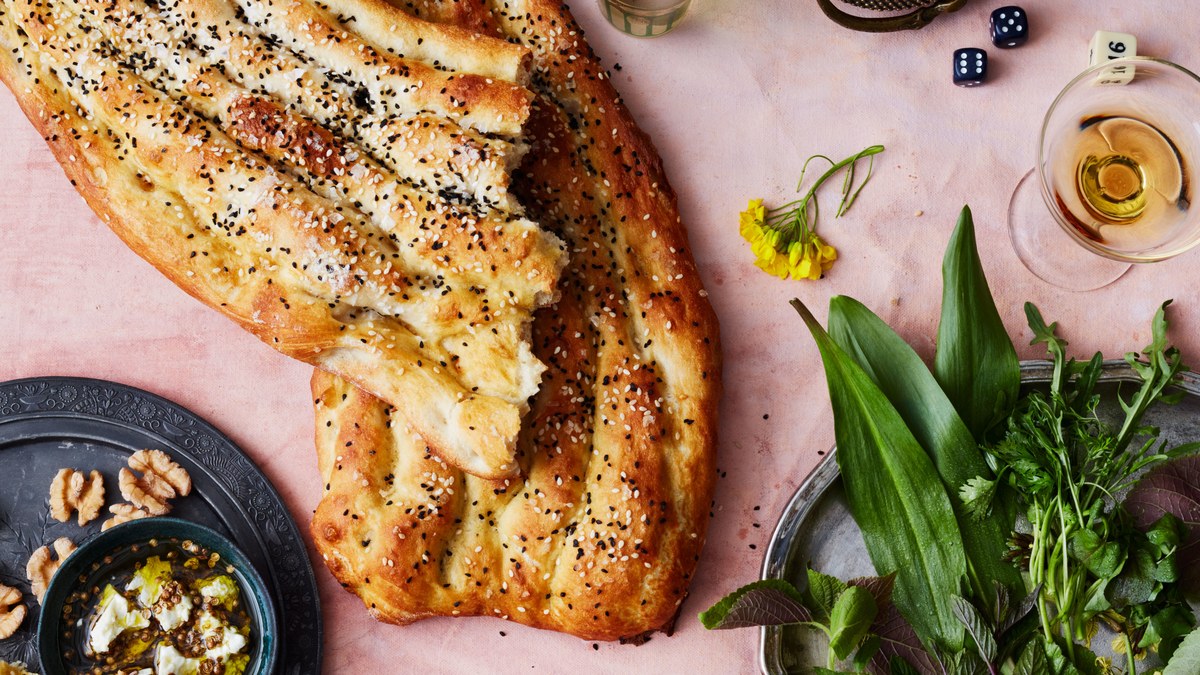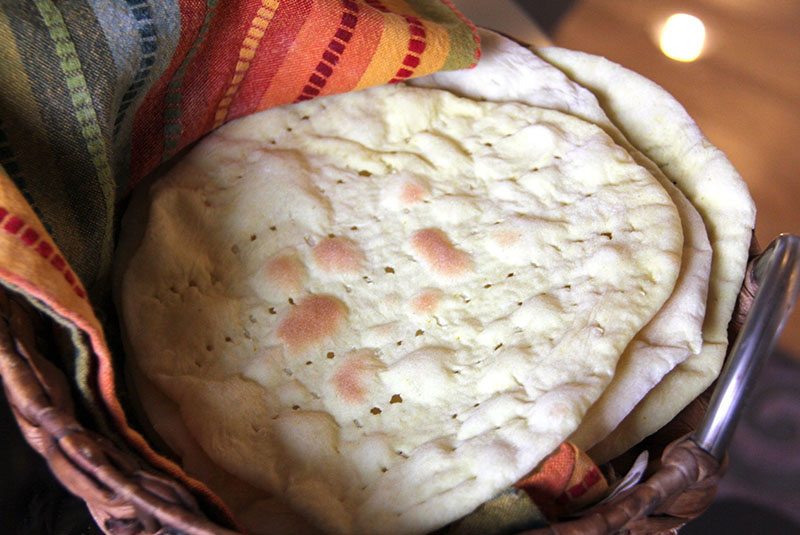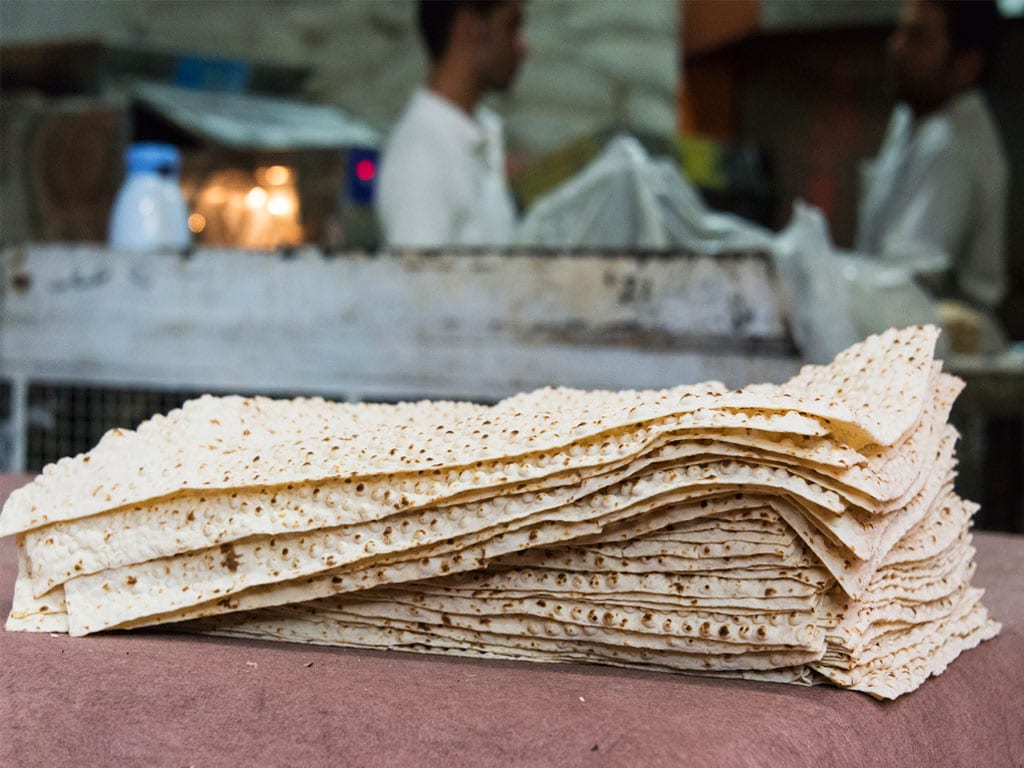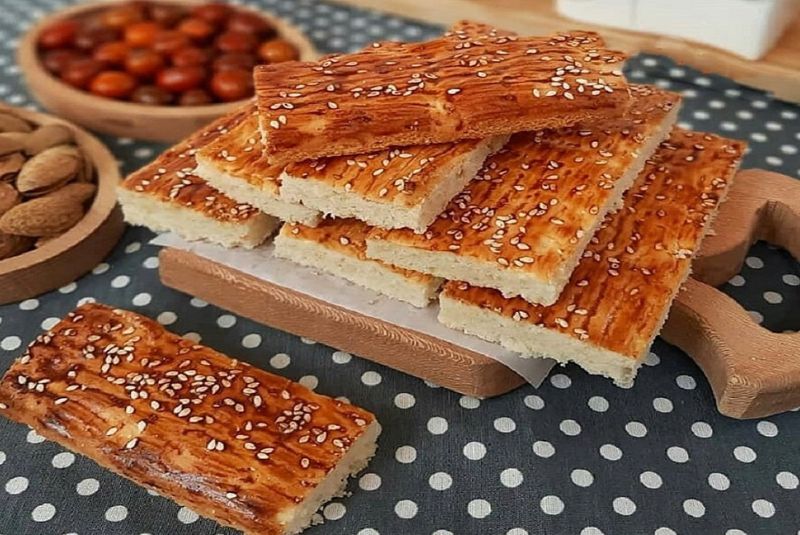Persian Bread: Different Types of Bread in Iran
In addition to a number of historical monuments in Iran, when you travel to Iran you will understand the diversity of cuisine in the country.
Not only the type of dishes, but also sweets, pickles, pastry, and bread! There are four types of Persian bread that are very popular and mostly used by people, named Barbari, Sangak, Taftoon, and Lavash. However, there are also some other types in every village and city around the country. In this article, we are going to talk about the most popular type of bread in Iran.
Different Types of Persian Bread
- BarBari
- Sangak
- Taftoon
- Lavash
- Noon-e Qandi
Barbari: The Crusty and Fluffy Bread!

The word “Barbari” means belong to Barbar, and Barbar stands for a group of people who lived in the northeast of Iran. The bread got its name since the bread was baked in that area and brought to Tehran. Barbari is a tick, flatbread about 70
Key characteristics of Barbari bread include:
- Crispy Crust: The hallmark of Barbari is its thick, crispy crust, which results from being baked at high temperatures. The dough's surface is brushed with a mixture of water and flour just before baking, promoting the development of a golden, crackly crust.
- Soft and Chewy Center: Beneath the crust lies a soft and chewy interior that showcases the artistry of the bakers. The dough is prepared with a combination of wheat flour, yeast, water, and salt, allowing for a gradual fermentation process that yields the bread's fluffy texture.
- Longitudinal Lines: The signature long lines running parallel to the length of the bread are created by the baker's skilled hand, using a tool called a "bread stamp" or a "bread lame." These lines serve not only an aesthetic purpose but also help control the bread's rising during baking.
Sangak: The Stone-Baked Flatbread!

Sangak in a word means little stone (Sang stands for stone). Since the bread is baked in an oven, on a bed of small stones it got its name. It is a plain, rectangular whole wheat bread. Some bakeries add different types of toppings such as sesame, dried herbs, and caraway.
It’s very popular to eat Kebab, Dizi, and Abgoosht with Sangak. Sangak is not only popular in Iran but also in Azerbaijan.
To make Sangak bread, the following steps are followed:
- Dough Preparation: The dough is made from whole wheat flour, water, yeast, and salt. The ingredients are mixed thoroughly, and the dough is left to rise, allowing the yeast to ferment and create air pockets, contributing to the bread's lightness.
- Stone-Baking: The unique aspect of Sangak lies in its baking process. Large, flat stones or pebbles are heated in a special oven called a "Tanur." Once the stones are scorching hot, the rolled-out dough is gently placed on top of them. The bread sticks to the hot surface, creating a characteristic pattern of small holes and depressions on one side.
- Flipping and Finishing: After a brief period, the bread is carefully flipped to expose the other side to the heat, ensuring even baking. Once fully cooked, Sangak is taken out of the oven, producing a crispy, golden crust on the outside and a soft, chewy texture on the inside.
Read more: The most delicious food in Iran
Taftoon: The Traditional Iranian Bread!

Tafton, Taftan, or
Key features of Taftoon bread include:
- Circular Shape: Taftoon is typically round, with a diameter of about 12 to 15 inches. Its circular form adds to the aesthetics and appeal of the bread.
- Slightly Thick Texture: Unlike some other Iranian flatbreads, Taftoon has a slightly thicker and softer texture. The dough is rolled out to achieve the desired thickness, allowing it to puff up beautifully during baking.
- Use of Yogurt and Milk: What sets Taftoon apart is the incorporation of yogurt and milk into the dough, which contribute to its distinct taste and tenderness. The combination of these dairy ingredients adds a subtle tanginess and richness to the bread.
- Baking Method: Traditionally, Taftoon is baked in a tandoor, a cylindrical clay oven. The dough is stuck to the inner walls of the tandoor, where it bakes at high temperatures, resulting in a crusty exterior and a soft, chewy interior.
Read more: Top 20 Persian food that you should try when traveling to Iran
Lavash: The Thin and Soft Bread!

Lavash Bread is round and the thinnest bread among all the different types of bread we have in Iran. The bread is one of the most common types of bread in Armenia, Azerbaijan, Iran, and Turkey.
In 2014 Lavash Bread, the preparation, and its meaning were listed as Intangible Cultural Heritage of Humanity of UNESCO from Armenia. However, after two years, in 2016, the countries of Azerbaijan, Iran, Kazakhstan, Kyrgyzstan, and Turkey were also added to the list of representatives.
Key characteristics of Lavash bread include:
- Thin and Elastic: Lavash is rolled out into thin sheets of dough, resulting in a soft and elastic texture. Its pliability makes it ideal for wrapping around fillings or folding into various shapes.
- Quick Baking: Due to its thinness, Lavash bakes quickly in a hot oven or on a hot griddle, making it a convenient and efficient choice for daily consumption.
- Minimal Ingredients: The simple ingredients used to make Lavash typically include wheat flour, water, and a pinch of salt. This straightforward recipe allows its natural flavors to shine through.
- Large Size: Lavash is often prepared in large sheets, making it suitable for sharing with a group of people or for creating ample servings for various dishes.
Noon-e Qandi - The Sweet Persian Bread
Noon-e Qandi, also known as Noon-e Sangak-e Qandi, is a delectable sweet bread that holds a special place in Persian cuisine and culture. Its name, "Qandi," is derived from the Persian word "qand," meaning sugar, which highlights its sweet nature. This traditional bread has been cherished for generations, and its preparation and consumption are steeped in rich cultural customs and festivities.
Ingredients and Preparation Process
The preparation of Noon-e Qandi is an art that requires skill and attention to detail. The main ingredients used in making this sweet bread are:
- Wheat Flour: High-quality wheat flour is the foundation of Noon-e Qandi, providing the necessary structure and texture.
- Sugar: As the name suggests, sugar plays a central role in giving the bread its sweetness. The type and amount of sugar used can vary, allowing for different variations in taste.
- Butter or Oil: To enhance the richness of the bread, butter or oil is often added to the dough.
- Saffron and Spices: Some recipes may incorporate saffron and various spices to add flavor and aroma to the bread.

The preparation process involves several steps:
- Mixing the Dough: The wheat flour is combined with sugar, butter or oil, and other optional ingredients in a mixing bowl. Water or milk is added gradually to form a soft and pliable dough.
- Kneading: The dough is then kneaded thoroughly to ensure proper gluten development, which results in the bread's desirable texture.
- Resting: The dough is allowed to rest and rise for a specific period, allowing it to ferment slightly and develop its unique taste.
- Shaping: Traditionally, Noon-e Qandi is shaped into round or oval discs, resembling a flatbread.
- Baking: The shaped dough is baked in a tandoor (a clay oven), which imparts a delightful smoky flavor and creates a crisp outer crust while maintaining a soft and tender interior.
Consumption during Special Celebrations and Holidays
Noon-e Qandi holds cultural significance as a celebratory bread, often prepared and enjoyed during special occasions and festive gatherings. Some of the notable occasions when Noon-e Qandi is savored include:
- Nowruz (Persian New Year): Noon-e Qandi is a must-have during the Nowruz festivities, which typically take place on the spring equinox. Families come together to celebrate the new year and the arrival of spring, and this sweet bread is an integral part of the festive spread.
- Mehregan: Mehregan is a Persian festival that celebrates love and friendship. During this time, Noon-e Qandi is shared with friends and loved ones as a gesture of affection.
- Weddings and Engagements: Noon-e Qandi is often served at weddings and engagement ceremonies, symbolizing sweetness and prosperity for the newlyweds.
- Religious Celebrations: The bread is also an essential component of various religious ceremonies and commemorations in Persian culture.
Noon-e Qandi's delightful sweetness and cultural significance make it a cherished treat that brings people together during joyous occasions. It not only satisfies the palate but also serves as a reminder of the rich traditions and customs that have been passed down through generations in Iran.

Local and Regional Bread Varieties
Iran's diverse geography and rich cultural heritage have given rise to a plethora of local and regional bread varieties, each reflecting the unique tastes and traditions of its respective area. These regional specialties add a delightful dimension to Iran's culinary landscape, with each bread type offering its own distinct flavors and textures.
- Barbari - Tehran: Barbari bread, known for its crispy crust and fluffy interior, is a popular specialty in Tehran, the capital city of Iran. It is widely available in local bakeries and is a staple on breakfast tables across the city.
- Sangak - Isfahan: Sangak, the stone-baked flatbread, is particularly associated with Isfahan, a historic city renowned for its remarkable architecture. The locals take pride in their traditional Sangak, which is often enjoyed with local cheeses and fresh herbs.
- Taftoon - Tabriz: Taftoon bread finds its regional specialty in Tabriz, a city located in northwestern Iran. The Taftoon baked in Tabriz is distinctively hearty and may include a blend of whole wheat flour and other grains, providing a rustic texture.
- Lavash - Yazd: Lavash is beloved throughout Iran, but it holds a special place in Yazd, a desert city known for its distinct culture and architecture. The Lavash of Yazd is typically thinner and more delicate, perfect for wrapping around a variety of fillings.
Unique Ingredients and Flavors
One of the fascinating aspects of Iran's local and regional bread varieties is the incorporation of unique ingredients and flavors that reflect the local produce and culinary preferences.
- Gilak - A specialty of the northern provinces of Iran, Gilak bread often contains a blend of cornmeal and wheat flour, lending it a slightly sweet and nutty flavor.
- Tabrizi Lavash - The Lavash made in Tabriz may include sesame seeds or black cumin, adding an aromatic and distinct taste to this regional specialty.
- Yazdi Bread - In Yazd, local bakers might infuse their Lavash with saffron or rosewater, enhancing the bread's aroma and making it even more delightful to the senses.
- Sourdough Variations - In some regions, bakers use sourdough starters to ferment their bread, adding tanginess and complexity to the flavor profile.

Modern Trends and Challenges in Iranian Bread-Making
In recent years, globalization has brought both opportunities and challenges to Iranian bread-making traditions. As the world becomes more interconnected, international culinary influences have seeped into Iran, leading to a shift in preferences and consumption patterns. This has impacted traditional bread varieties in several ways:
- Diversification of Bread Options: With increased exposure to global cuisines, Iranians have developed a taste for a wider range of bread, including Western-style loaves and pastries. This shift in consumer preferences has led to a decline in the demand for certain traditional bread varieties.
- Industrialization and Mass Production: Modern baking technologies and the rise of industrial bakeries have facilitated the mass production of bread, often leading to standardized flavors and textures. Traditional artisanal methods may be overshadowed by mass-produced alternatives.
- Imported Ingredients: Globalization has made it easier to access ingredients from around the world. While this can be advantageous for some aspects of Iranian cuisine, it may also lead to the use of foreign ingredients that deviate from the authentic recipes of traditional bread.

Efforts to Preserve and Promote Traditional Bread-Making Techniques
Despite the challenges posed by globalization, there are concerted efforts to preserve and promote traditional bread-making techniques in Iran. Various individuals, organizations, and communities recognize the cultural importance of preserving this culinary heritage:
- Culinary Heritage Initiatives: Some organizations and culinary associations are actively involved in documenting traditional recipes and techniques, ensuring that they are passed down to future generations.
- Support for Local Bakeries: There is a growing movement to support and celebrate local bakeries that adhere to traditional methods. These bakeries are appreciated for maintaining the authenticity and unique flavors of regional bread varieties.
- Culinary Workshops and Education: To ensure that traditional bread-making techniques are not lost, culinary workshops and training sessions are organized to teach aspiring bakers the artistry of making traditional bread.
Bottom Line
Bread holds a profound and cherished significance in Iranian culture, extending far beyond its role as a basic staple food. It is deeply intertwined with social customs, religious practices, and everyday life. From the traditional stone-baked Sangak to the soft and chewy Taftoon, each bread variety reflects the rich culinary heritage and regional diversity of Iran. Bread's symbolic importance as a symbol of hospitality, generosity, and unity has been passed down through generations, making it an integral part of Iranian identity.
The importance of bread in Iranian culture goes far beyond mere sustenance. It represents the warmth of Iranian hospitality, the bond of shared meals, and the celebration of tradition. Embrace the journey of tasting the diverse array of Iranian bread, and you will be immersed in a delightful culinary adventure that unveils the heart and soul of this fascinating nation.


Comment
Leave a Comment